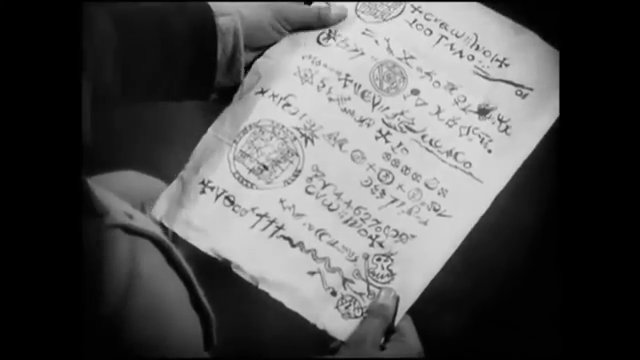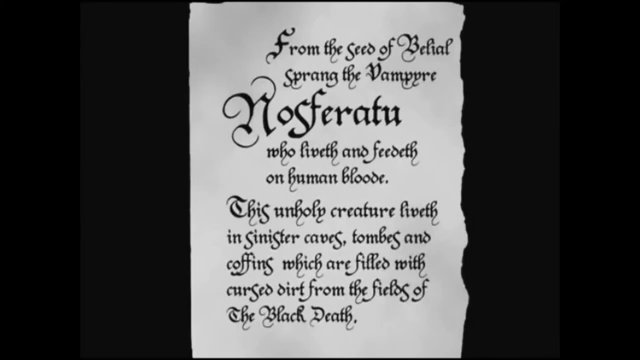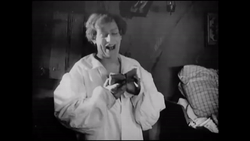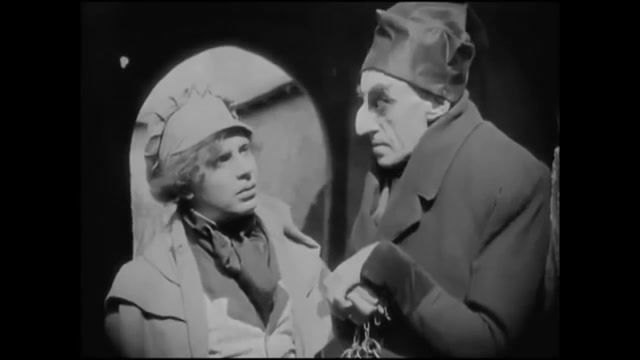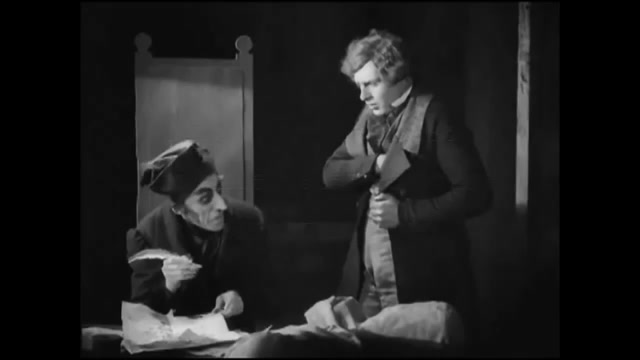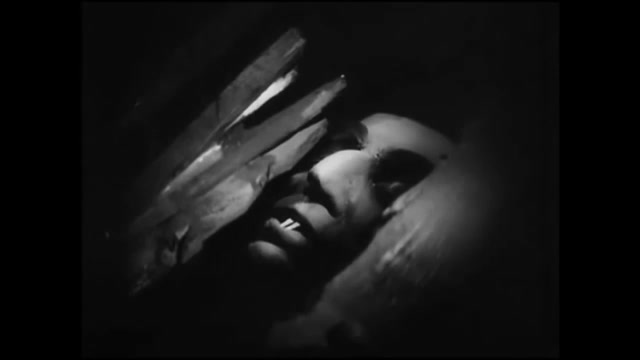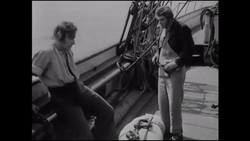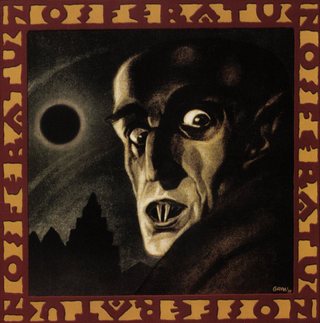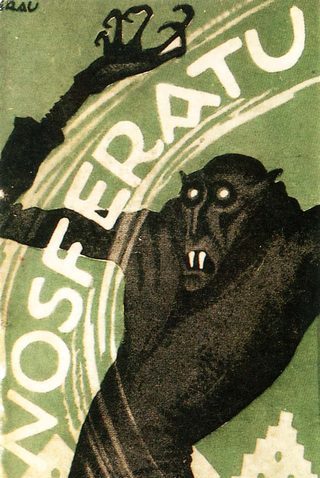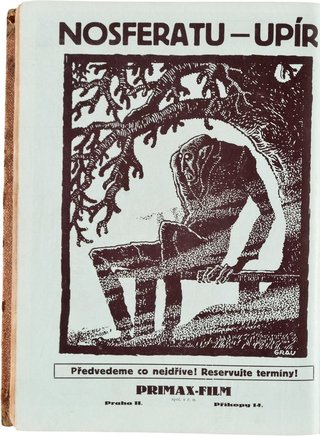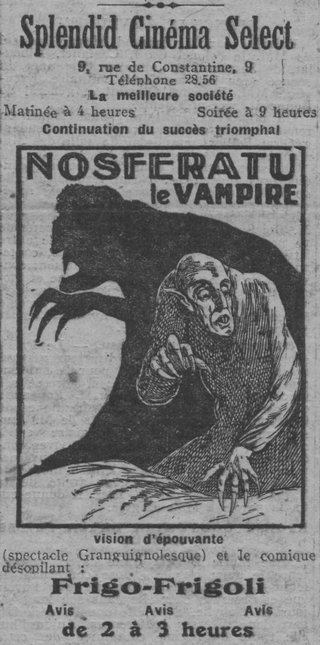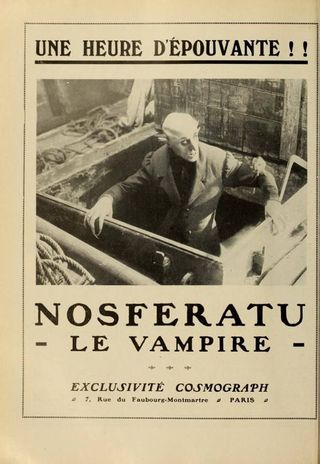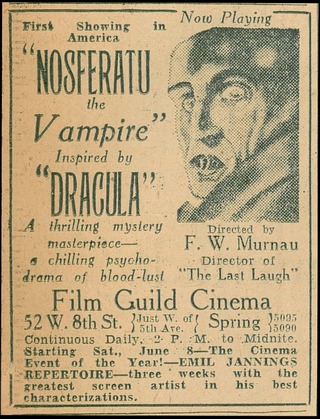Background music for your enjoyment: Ludwig van Beethoven - Sonata No 14 in C# minor, Presto
Prologue
Nosferatu is a German expressionist film. It rejects cinematic realism in favour of expressive performance and visual distortions, as a means to portray emotion and inner conflict.
Nosferatu is unofficially based on the book "Dracula" by Bram Stoker. The production company, Prana Film, did not acquire the rights to the book. To work around this they changed the character names, the location where the story takes place, and other details.
The film's footage almost became lost to history after a court ruling ordered it to be destroyed, as it infringed on copyright.
Luckily several prints survived - good fortune, as it's considered a cinematic masterpiece, and very influential in the horror genre.
The original musical score was lost to time, however many composers have recreated their own versions. There are dozens upon dozens of scores! Some are masterful, others are simply "needle-drop" replacements that fail to evoke the right emotions on screen.
A few versions are available in black & white, others are colour tinted. The original used tint to signify the scene - particularly for night time, which were filmed in daylight. Watching a black & white version gives the false impression of Count Orlok walking around during the day!
There is a lot of history around this film, if you are curious about finding out more, check out Brenton Film's History and Home Video Guide. Highly recommended!
Enough of that nonsense. Time for the review!
An Ominous Tale
"Unless I am mistaken, the master wants to buy a house and move here, to be closer to fresh bodies to feed on."
"... or this is the solution to last week's crossword. I can't really tell. Either way, let's send that fool Hutter to Transylvania to meet the master."
"Here you, young lad. You must travel to meet Count Orlok in the land of the phantoms. He must sign these papers. You will sell him that house over there, the one next to yours!"
Hutter packed his bags, got in the horse carriage and set out on his journey. Stopping in a village nearby the Carpathian mountains to rest, he finds an ominous book in the room he stays in. He tosses it aside incredulously.
"Ha ha ha. What nonsense."
Hutter continues his journey, until he reaches the Count's castle.
Hutter: "Hello sir. Your castle is impressive! Why move to the city?"
Orklok: "I need to feed ... my llamas. Yes I have llamas and there is no llama food out here in the mountains. You must be tired, come and dine."
Hutter: "Please sign the title to your new property, Count Orklok."
Orlok: "We shall be neighbours! You can visit my llama petting zoo at night."
After a good rest, Hutter awoke to find two punctures on his neck. Thinking nothing of it, he enjoys a hearty breakfast and explores the castle during the day. he writes a letter to his wife, telling of his safe arrival. A horseman arrives to take his letter away.
The next evening, Count Orlok treated Hutter to one of his famous display of shadow-puppets.
Hutter was disturbed by ghoulish nightmares from the night before. Suspecting there is something evil within the confines of the castle, he explores the basement.
He discovers a coffin, and beholds the grotesque visage of a sleeping count Orlok within! Hutter falls into a paralytic stupor from the shock.
Later that evening, Hutter looked through his bedroom window, Orlok was stacking coffins of dirt on a wagon, then the count got inside one of the coffins and the horses drew it away.
Hutter: "I have to get back home, before the count feeds on my wife!"
A strange plague takes the crew, one by one, aboard the ship transporting Orklok inside his dirt coffins.
The captain and first mate inspected the cargo hold, to discover a surprise within one of the coffins!
Thus the entirety of the crew is wiped out, and Count Orklok becomes the new captain of the ship.
Conclusion
Will Nosferatu feed on Hutter's wife, Ellen? Will Hutter reach her in time to save her? And how will they stop the evil plague that has come to their city?
I won't spoil the last part of this film for you, so this is where the captioned images stop.
This film is a great watch. The expressive acting is emotive, and the story makes sense even without having read the book "Dracula".
It is important to watch a version with good music. If the score doesn't suit the film, or is repetitive, it will lessen the experience - more than watching a black & white version, in my naïve opinion.
Posters
4th March, 1922 première souvenir programme by Albin Grau
Insert poster by Albin Grau
Advert with Albin Grau artwork in Czech film exhibitors’ book, c. 1926
Algiers Splendid Cinéma Select with some outdoor screenings
"An hour of terror!!" Cinéa magazine advert, 1922
US advert, June 1929
Various Versions to Watch
NOTE: The Internet Archive has temporarily shut down some of their services, while they deal with an attack on their network. This is a terrible thing, and I wish the IA team all the best with their valiant efforts. Meanwhile you can watch this film on other platforms, via the links below.
- Archive.org
- Youtube - Black & White, Jill Tracy score
- F.W. Murnau's 1922 silent vampire classic, Nosferatu— with award-winning score by Jill Tracy and The Malcontent Orchestra. Recorded LIVE.
- "I wanted to honor the integrity of the film," explained Jill Tracy in an SF Gate interview during the film score's debut. "I wanted to dispose of any camp element and seamlessly enhance the emotion of Murnau’s stunning visuals. I don’t see Nosferatu as inciting horror or trepidation, as much as an unsettling allure. It’s a beautiful, sensual work; the listener should surrender to the spell of the music as intensely as to the spell of the vampire."
- Youtube - Tinted, Heller’s reconstructed "original" score
- Berndt Heller reconstructed the original score, and although misleading, many versions claim this to be the original film score.
- Youtube - Tinted, James Bernard score
- Another noteworthy classical score, Bernard’s own symphony of horror had its première at a screening on the 17th November 1997 at London’s Royal Festival Hall. Nic Raine conducted the City of Prague Philharmonic Orchestra and the same ensemble then made a studio recording.

